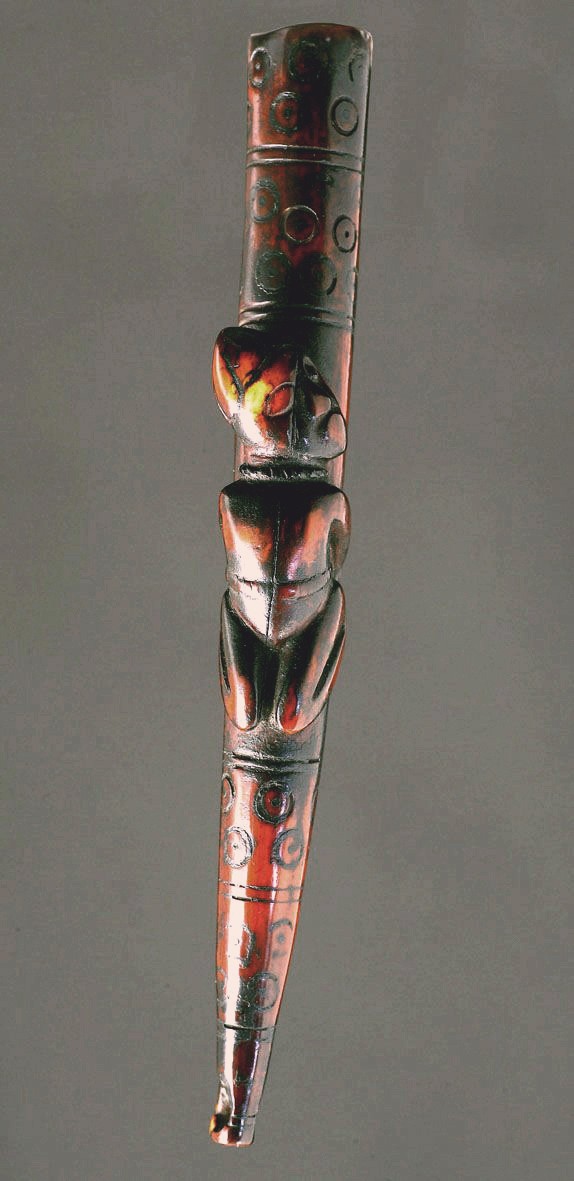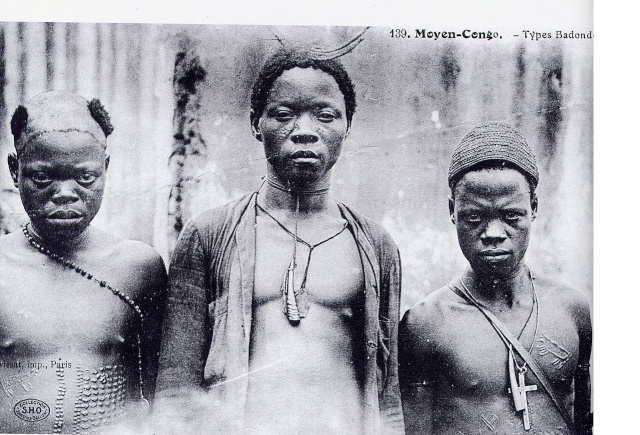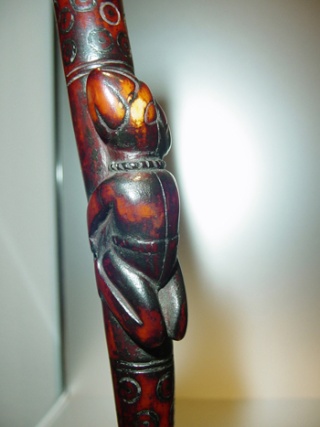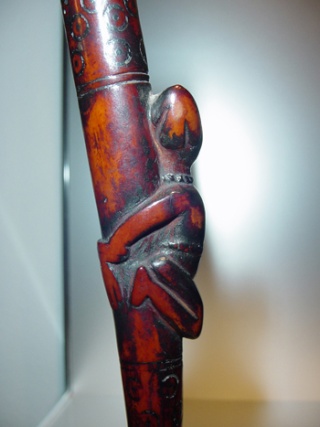Kongo people, Ritual Whistle, Lower Congo Region
Pagina 1 di 1
 Kongo people, Ritual Whistle, Lower Congo Region
Kongo people, Ritual Whistle, Lower Congo Region

Kongo people, Ritual Whistle, Lower Congo Region
17-18th century
Ivory, deep patina of use
H. 5,9 in/cm. 15
Private Collection Italy
Photo by Pietro Paletti
Arti delle Mani Nere All Rights Reserved
Provenance
Ex. Eglise Bougiste coll., Pointe Noire (Congo Brazzaville)
Ex Umberto Giacomelli coll. Milano
Exibition
L’Africa delle Meraviglie. Arti Africane nelle collezioni italiane. Museo Castello D’Albertis, Genova, 30 December 2010-5 June 2011.
Published
-Marc Leo Felix “ White gold, black hands. Ivory sculpture in Congo” vol. I, Edited by Marc Leo Felix, Brussels, Belgium, 2010, pag.220, fig.342a, 342b color.
-Bargna I, e Parodi da Passano G., L'Africa delle meraviglie - Arti africane nelle collezioni italiane, Genova, 2010, Silvana Editoriale, Cinisello Balsamo (MI), pag. 200, color
-Rivista Qui Brescia, anno 7, n. 65, dicembre 2010, Brescia, pag. 142, color
-A. Lecomte, R. Lehuard, B. Södeberg, "Les sifflets Bakongo. Lower Congo Whistles", Paris, 2013, Editions Alain Lecomte, pag.74 and 75, color

This ritual whistle, called 'NSIBA', cone-shaped, decorated with the classic point / circle, is a representation of a human figure, probably a slave sacrificed, in view of unnatural posture of the head and the presence of tied hands.
Comes from Pointe Noire, Congo Brazzaville, was gathered by Eglise Bougiste, founded by Zephyrin Lassy '"...combattant les rytes fétichistes....faisant détruire ou saisir par ses disciples amulettes et talismans', ( J.Millot,1961).
In Ki-Kongo language, the whistle used by hunters is also referred NKISSI-NIAMBI, namely, 'The Spirit of the hunt'.

This ritual sifflet was produced most likely in the town of Loango. The Kingdom of Loango flourished in the seventeenth century, as evidenced by missionaries and travelers, including O. Dapper, which produced the note press of the City of 'Louango' in 1686.
The 'King', Ma-Lwangu, was surrounded by a court of 'principles' with specific functions (Ma-Ngouo, Ma-Kaka etc) that gave rise, among other things, to a specific 'Art of the Court'.
Between the end of 1700 and in 1800 began the decline. The last Ma-Lwangu, for years within power, died around 1940 and was buried in Loandjili. The actual village of Loango and Loandjili, are place near Point Noire, where the whistle picked up.
Marc Felix wrote about the object "En ce qui concerne le sifflet, que je trouve esthéticament merveilleux...je n'en ai jamais vu d'autre qui lui ressemble...car je ne voyais pas le lien entre une victime sacrificielle et un sifflet.... La sculture du sifflet est tout à fait remarquable et il dégage une émotion pathétique et émouvante."
Didier Claes: très beau et très ancien!
Bibliography
- S.Chauvet Musique nègre, Ed. Société d'éditions géographiques, maritimes et coloniales, Paris, 1929.
-J. Millot "Objets et Monde: la Revue du Musée de l'Homme", Paris, Autumn 1961:65
-J. Vansina, “ The Tio Kingdom of the Midle Congo 1880-1892”, Oxford University Press, London, 1973
-F. Hagenbuchek-Sacripantiles, "Fondaments spirituels du pouvoir au Royaume du Loango. République populaire du Congo", Ethnologue de I'ORSTOM,O.R.S.T.O.M. Paris 1973
-R. Lehuard, “Art Bakongo. Les centres de style”, Villiers-le-Bel, France Arts d’Afrique Noire, 1989
-M.L. Felix, ”Art & Kongos”, Tribal Arts, sprl. Bruxelles, 1995
-O. Massoumou, A.J.M. Queffélec, "Le français en République du Congo: Sous l'ère pluripartiste (1991-2006)", Edition des archives contemporaines, Paris, 2007
-M.L. Felix “ White gold, black hands. Ivory sculpture in Congo” vol. I, Edited by M. L. Felix, Brussels, Belgium, 2010
-A. Lecomte, R. Lehuard, B. Södeberg, "Les sifflets Bakongo. Lower Congo Whistles", Paris, 2013, Editions Alain Lecomte
Yale University Art Gallery
N. 0072808

Kongo people, Fischietto rituale, Lower Congo Region
XVII-XVIII sec.
Avorio, profonda patina d'uso
H. cm.15
Collezione privata, Italia
Foto di Pietro Paletti
Arti delle Mani Nere All Rights Reserved
Provenienza
Ex coll. Eglise Bougiste di Pointe Noire (Congo Brazzaville)
Ex coll. Umberto Giacomelli, Milano
Esposizioni :
L’Africa delle Meraviglie. Arti Africane nelle collezioni italiane. Museo Castello D’Albertis, Genova, 30 dicembre 2010-5 giugno 2011.
Pubblicazioni
-Marc Leo Felix “ White gold, black hands. Ivory sculpture in Congo” vol. I, Edited by Marc Leo Felix, Brussels, Belgium, 2010, pag.220, fig.342a, 342b color.
- Bargna I, e Parodi da Passano G., L'Africa delle meraviglie - Arti africane nelle collezioni italiane, Genova, 2010, Silvana Editoriale, Cinisello Balsamo (MI), pag. 200, color
- Rivista Qui Brescia, anno 7, n. 65, dicembre 2010, Brescia, pag. 142, color
-A. Lecomte, R. Lehuard, B. Södeberg, "Les sifflets Bakongo. Lower Congo Whistles", Paris, 2013, Editions Alain Lecomte, pag.74 and 75, color
Questo rital sifflet, denominato 'NSIBA', di forma conica, decorato con il classico punto/circolo è la rappresentazione di una figura umana , probabilmente uno schiavo sacrificato, se si osserva la postura innaturale della testa ed il fatto di avere le mani legate.

Proviene da Pointe Noire, Congo Brazzaville, e fu raccolto dall'Eglise Bougiste, fondata da Zephyrin Lassy che “...combattant les rytes fétichistes....faisant détruire ou saisir par ses disciples amulettes et talismans”, ( J.Millot, 1961) .
In languaggio Ki-Kongo, il sifflet utilizzato dai cacciatori è anche denominato NKISSI-NIAMBI, e cioè, ' Spirito della caccia'.
Questo sifflet rituale è stato prodotto con ogni probabilità nella città di Loango. Il Regno di Loango era fiorente nel XVII sec., come testimoniano missionari e viaggiatori, fra i quali O.Dapper che produsse la nota stampa della Città di 'Louango' del 1686.
Il 'Re', Ma-Lwangu, era circondato da una corte di 'principi' con funzioni specifiche (Ma-Ngouo, Ma-Kaka etc.) che dettero luogo, fra l'altro, ad una specifica 'Arte di Corte'.
Tra la fine del 1700 e nel corso del 1800 cominciò la decadenza. L'ultimo Ma-Lwangu, ormai da anni senza potere effettivo, morì verso il 1940 e fu sepolto a Loandjili. L'attuale villaggio di Loango e Loandjili, si trovano nelle vicinanze di Pointe Noire luogo in cui è stato raccolto il sifflet.
Marc Felix ha scritto in riferimento all’oggetto:
“En ce qui concerne le sifflet, que je trouve esthéticament merveilleux...je n'en ai jamais vu d'autre qui lui ressemble...car je ne voyais pas le lien entre une victime sacrificielle et un sifflet.... La sculture du sifflet est tout à fait remarquable et il dégage une émotion pathétique et émouvante."
Didier Claes: bellissimo e molto antico!
Bibliografia.
- S.Chauvet Musique nègre, Ed. Société d'éditions géographiques, maritimes et coloniales, Paris, 1929.
-J. Millot in "Objets et Monde: la Revue du Musée de l'Homme', Paris, Autumn 1961:65
-J. Vansina, “ The Tio Kingdom of the Midle Congo 1880-1892”, Oxford University Press, London, 1973
-F. Hagenbuchek-Sacripantiles, "Fondaments spirituels du pouvoir au Royaume du Loango. République populaire du Congo", Ethnologue de I'ORSTOM, O.R.S.T.O.M. Paris 1973
-R. Lehuard, “Art Bakongo. Les centres de style”, Villiers-le-Bel, France Arts d’Afrique Noire 1989
-M.L. Felix, ”Art & Kongos”, Tribal Arts, sprl. Bruxelles, 1995
-O. Massoumou, A.J.M. Queffélec, Le français en République du Congo: Sous l'ère pluripartiste (1991-2006), Edition des archives contemporaines, Paris, 2007
-M.L. Felix “ White gold, black hands. Ivory sculpture in Congo” vol. I, Edited by M. L. Felix, Brussels, Belgium, 2010
-A. Lecomte, R. Lehuard, B. Södeberg, "Les sifflets Bakongo. Lower Congo Whistles", Paris, 2013, Editions Alain Lecomte
Yale University Art Gallery
Numero di archivio 0072808

Pagina 1 di 1
Permessi in questa sezione del forum:
Non puoi rispondere agli argomenti in questo forum.
 Indice
Indice